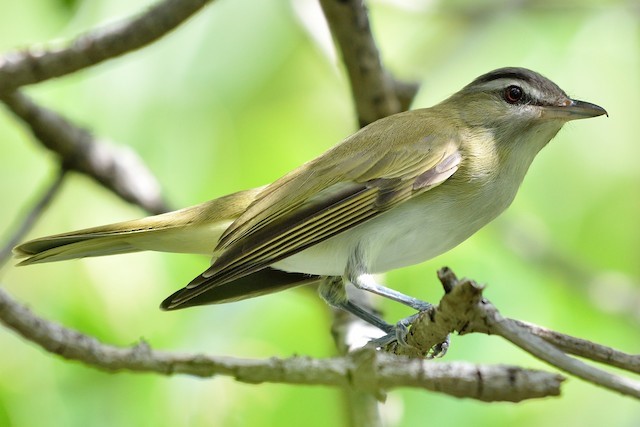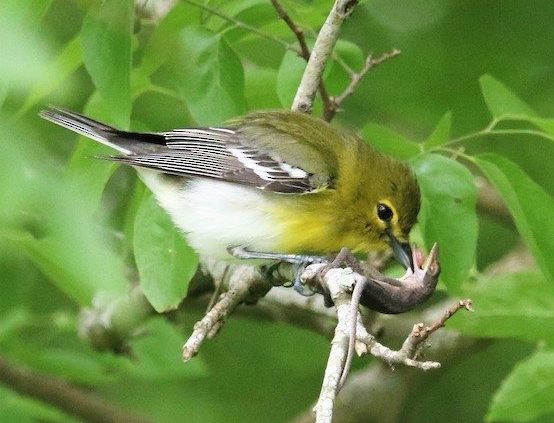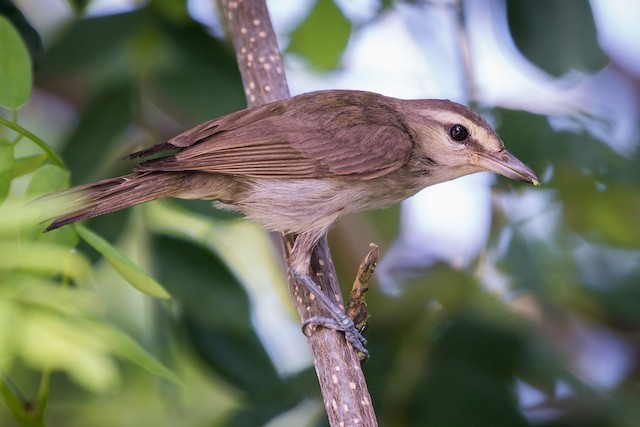Vireonidae: Vireos
The vireos are a New World family of songbirds best known for the persistent, repetitive singing of some species. In appearance and habits, they resemble warblers—small, active insect-gleaners that work mainly in the foliage of trees and bushes—but are more robust, with heavy, hook-tipped bills, and are slower and more deliberate in their movements. Their formidable bills equip vireos for a wide range of prey, often including lizards.
Typical vireos, of the genus Vireo, are predominantly olive or gray, with brighter shades of yellow in a few species. They breed from Alaska to Patagonia and reach their peak diversity in Middle America. Three other groups of vireonids are widely distributed in the Neotropics from Mexico to Argentina. Like the typical vireos, these groups are fairly homogeneous and each is currently regarded as a single genus: greenlets (Hylophilus); shrike-vireos (Vireolanius); and peppershrikes (Cyclarhis).
Vireos are part of the corvoid evolutionary branch, along with crows and shrikes. Recent research has shown that the vireos’ closest relatives are two Asian families, the shrike-babblers and the Erpornis, which diverged from vireos approximately 30 million and 24 million years ago, respectively. Some taxonomists favor classifying them together with the vireos as a single family to recognize their shared heritage.
Identification
Many groups of vireo species are extremely similar, with subtle differences in plumage tones that are often useless in field identification. In some cases, the variability within species far exceeds any visible differences between species. Most of the non-migratory species can be distinguished based on geography, but some are migratory or dispersive and overlap to some degree with their sibling species.
Differences in vocalizations are significant in some cases—especially considering that voice is probably the principal factor that would determine whether two similar forms recognize one another as different. However, voice can be difficult to factor into field identification because many vireo species sing varied phrases in tones that sound alike to human ears.
Taxonomy
The total number of vireo species, as currently understood, is in the range of 55 to 73, in three subfamilies:
Cyclarhidinae: Peppershrikes (2 to 7 species)
Vireolaniinae: Shrike-vireos (5 species)
Vireoninae: Vireos and greenlets (48 to 61 species)
The vireo family presents many unresolved taxonomic puzzles. Many long-accepted “species” have been split into multiple species, and future splits are likely. Areas of ongoing study and uncertainty include these:
- The peppershrikes have traditionally been considered two species, Rufous-browed and Black-billed, but recent genetic studies seem to prove that some Rufous-browed are more closely related to Black-billed than they are to other Rufous-browed. So Rufous-browed will almost certainly be subdivided into multiple species, probably more than two.
- Greenlets have been considered a single branch of vireo family tree, all classified in the genus Hylophilus, but genetic analyses indicate that this is incorrect. In terms of relatedness, the greenlets are clustered in three branches: the “scrub greenlets,” the “tawny-crowned greenlets,” and the “canopy greenlets.” These branches are probably distinct enough to be classified as separate genera.
- The traditionally recognized greenlet and vireo groups each include one member that likely belongs in the other group. The Golden Vireo appears to be a member of the “canopy greenlets,” and the Tepui Greenlet is now generally considered to be a Vireo of the “warbling vireo” group.
- Certain Vireo species are internally diverse, with subtle variations in plumage and consistent vocal differences that may lead to recognition as multiple species. What was traditionally known as the Solitary Vireo in North America is now regarded as at least three and possibly up to five species. The four forms of Mangrove Vireo found in various parts of Mexico and Central America may be visually indistinguishable, but differ in voice and ecology, likely sufficient to classify them as separate species.
Rufous-browed Peppershrike (Cyclarhis gujanensis)
“Northern Peppershrike” (C. g. flaviventris)
“Cozumel Peppershrike” (C. g. insularis)
“Rufous-browed Peppershrike” (C. g. gujanensis)
“Yellow-backed Peppershrike” (C. g. virenticeps)
“Chaco Peppershrike” (C. g. viridis)
“Ochre-crowned Peppershrike” (C. g. ochrocephala)
Black-billed Peppershrike (Cyclarhis nigrirostris)
Chestnut-sided Shrike-Vireo (Vireolanius melitophrys)
Green Shrike-Vireo (Vireolanius pulchellus)
Yellow-browed Shrike-Vireo (Vireolanius eximius)
Slaty-capped Shrike-Vireo (Vireolanius leucotis)
Pale-legged Shrike-Vireo (Vireolanius mikettae)
Rufous-crowned Greenlet (Hylophilus poicilotis)
Gray-eyed Greenlet (Hylophilus amaurocephalus)
Olivaceous Greenlet (Hylophilus olivaceus)
Ashy-headed Greenlet (Hylophilus pectoralis)
Scrub Greenlet (Hylophilus flavipes)
Gray-chested Greenlet (Hylophilus semicinereus)
Brown-headed Greenlet (Hylophilus brunneiceps)
Lemon-chested Greenlet (Hylophilus thoracicus)
Tawny-crowned Greenlet (Hylophilus ochraceiceps)
“Tawny-crowned Greenlet” (H. o. ochraceiceps)
“Red-fronted Greenlet” (H. o. rubrifrons)
Golden Vireo (Hylophilus hypochryseus)
Dusky-capped Greenlet (Hylophilus hypoxanthus)
Buff-cheeked Greenlet (Hylophilus muscicapinus)
Rufous-naped Greenlet (Hylophilus semibrunneus)
Golden-fronted Greenlet (Hylophilus aurantiifrons)
Lesser Greenlet (Hylophilus decurtatus)
“Lesser Greenlet” (H. d. decurtatus)
“Gray-headed Greenlet” (H. d. minor)
Blue Mountain Vireo (Vireo osburni)
Flat-billed Vireo (Vireo nanus)
Jamaican Vireo (Vireo modestus)
Bell’s Vireo (Vireo bellii)
“Bell’s Vireo” (V. b. bellii)
“Arizona Vireo” (V. b. arizonae)
“Least Vireo” (V. b. pusillus)
Puerto Rican Vireo (Vireo latimeri)
Black-capped Vireo (Vireo atricapilla)
Dwarf Vireo (Vireo nelsoni)
Slaty Vireo (Vireo brevipennis)
Mangrove Vireo (Vireo pallens)
“Sinaloa Vireo” (V. p. paluster)
“Belize Vireo” (V. p. semiflavus)
“Ochraceous Vireo” (V. p. ochraceus)
“Mangrove Vireo” (V. p. pallens)
Cozumel Vireo (Vireo bairdi)
San Andrés Vireo (Vireo caribaeus)
Thick-billed Vireo (Vireo crassirostris)
Providencia Vireo (Vireo approximans)
White-eyed Vireo (Vireo griseus)
Cuban Vireo (Vireo gundlachii)
Gray Vireo (Vireo vicinior)
Hutton’s Vireo (Vireo huttoni)
“Hutton’s Vireo” (V. h. huttoni)
“Stephens’s Vireo” (V. h. stephensi)
Yellow-throated Vireo (Vireo flavifrons)
Yellow-winged Vireo (Vireo carmioli)
Chocó Vireo (Vireo masteri)
Plumbeous Vireo (Vireo plumbeus)
“Plumbeous Vireo” (V. p. plumbeus)
“Guatemalan Vireo” (V. p. notius/montanus)
Cassin’s Vireo (Vireo cassinii)
“Cassin’s Vireo” (V. c. cassinii)
“San Lucas Vireo” (V. c. lucasanas)
Blue-headed Vireo (Vireo solitarius)
Tepui Greenlet (Vireo sclateri)
Warbling Vireo (Vireo gilvus)
“Eastern Warbling Vireo” (V. g. gilvus)
“Western Warbling Vireo” (V. g. swainsoni)
Philadelphia Vireo (Vireo philadelphicus)
Brown-capped Vireo (Vireo leucophrys)
Yucatán Vireo (Vireo magister)
Red-eyed Vireo (Vireo olivaceus)
Chivi Vireo (Vireo chivi)
“Northern Chivi Vireo” (V. c. agilis)
“Southern Chivi Vireo” (V. c. chivi)
Noronha Vireo (Vireo gracilirostris)
Yellow-green Vireo (Vireo flavoviridis)
“Yellow-green Vireo” (V. f. flavoviridis)
“Tamaulipas Vireo” (V. f. ssp. nova)
References
Jønsson, K.A., P-H. Fabre, J.D. Kennedy, B.G. Holt, M.K. Borregaard, C. Rahbek, and J. Fjeldså. 2016. A supermatrix phylogeny of corvoid passerine birds (Aves: Corvides). Molecular Phylogenetics and Evolution 94: 87-94.
Reddy, S. 2008. Systematics and biogeography of the shrike-babblers (Pteruthius): Species limits, molecular phylogenetics, and diversification patterns across southern Asia. Molecular Phylogenetics and Evolution 47: 54-72.
Reddy, S., and J. Cracraft. 2007. Old World Shrike-babblers (Pteruthius) belong with New World Vireos (Vireonidae). Molecular Phylogenetics and Evolution 44: 1352-1357.
Roberson, D. 2014. Bird Families of the World: Shrike-Babblers: Pteruthiidae, http://creagrus.home.montereybay.com/shrike-babblers.html. (Posted March 26, 2014. Accessed August 4, 2018.)
Roberson, D. 2014. Bird Families of the World: Erpornis: Erpornithidae, http://creagrus.home.montereybay.com/Erpornis.html. (Posted March 30, 2014. Accessed August 4, 2018.)
Roberson, D. 2016. Bird Families of the World: Vireos & allies: Vireonidae, http://creagrus.home.montereybay.com/vireos.html. (Posted March 9, 2016. Accessed August 4, 2018.)
Slager, D.L., C.J. Battey, R.W. Bryson Jr, G. Voelker, and J. Klicka. 2014. A multilocus phylogeny of a major New


